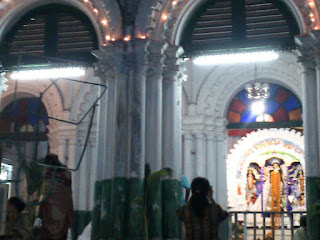async="" crossorigin="anonymous" src="https://pagead2.googlesyndication.com/pagead/js/adsbygoogle.js?client=ca-pub-6973460484243747">
Today, I would like to tell about the 340 years old Durga Puja of Serampore Goswami family's traditional Durga puja. Their house is a royal palace (Raj Bari) built about 300 years ago.
Serampore is a town of Hooghly district of West Bengal, India. This town is located near Kolkata. It is a very old town, occupied by Dutch during British raj in India.
This royal palace of Goswami family is situated on the bank of river Ganges near ferry ghat. When I entered at the house, seen the big structure at the middle 'chandni' or 'Naat Mandir'. It is made of 24 corinthian columns and occupied 130×30 feet area.
I stood under this 'chandni' and found the 'Thakur Dalan' (where the deity offered puja). Its floor is made of marble. Its outer walls and pillars are well-decorated with cement plaster. On both sides of stairs I found old gaslights.
The 'Nabo Patrika' or 'Kala bou' use to bath at 'Saptami' on this 'dalan' and 'Kumari Puja' is performed on 'Nabami' day.
The main attraction of this puja is the deity - which is unique. 340 years ago, the ancestor of this Goswami family - Ramgobinda Goswami first performed the puja with an expense of just Rs. 50 which is a dream-like news today. Besides Durga puja, Kali, Lakhsmi, Saraswati puja and Dolyatra, Jhulan yatra, Janmastami and Raas yatra also use to perform at this Thakur Dalan. The family god of the Goswami is Radhamadhav Jiu.
It is very famous house as film shootings are done in this house since the time of Uttam Kumar. In the year 1963, shooting of the Bengali film 'Nishithe', starred Uttam Kumar and Supriya Devi, was done in this house. Recently, the shooting of Bengali movie 'Bhooter Bhabishyat' (The future of ghosts) was done in this house.





Comments